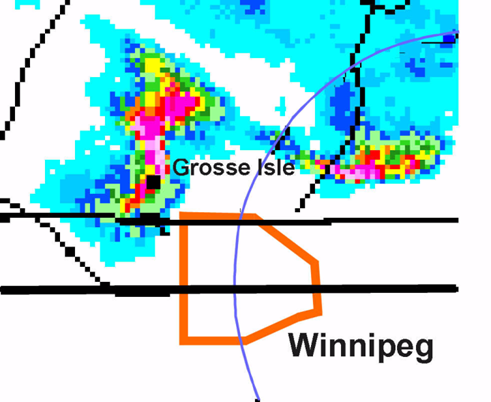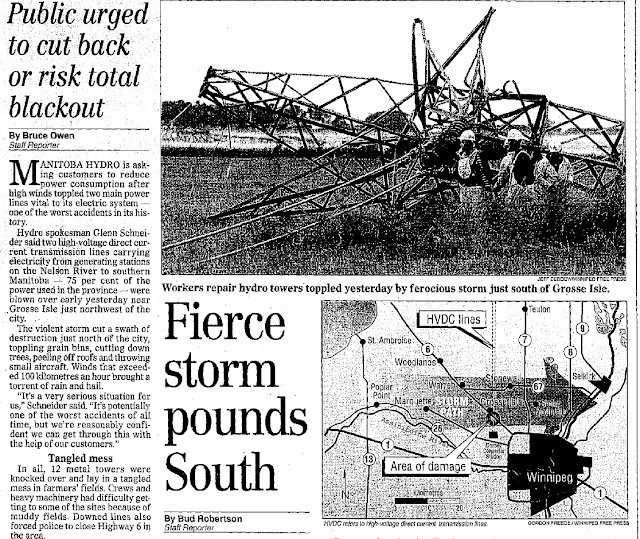September 5, 1996 Bow Echo Downed 19 Vital Hydro Towers
A warm front advancing northward from North Dakota produced some wild weather in southern Manitoba on September 5, 1996. Thunderstorms developed east of Portage la Prairie during the overnight hours and quickly became severe. The storms developed well north of the warm front, which was still in North Dakota. The warm front did not reach Winnipeg until the evening, pushing temperatures and humidity upwards. Despite only reaching 22°C in the afternoon, a sudden switch in wind direction from northeasterly to southerly by 9pm increased temperatures to 26°C. Temperatures fell back below 20°C late in the overnight on the 6th as a cold front moved through.
The storms during the overnight hours of the 5th were destructive. The storm east of Portage la Prairie quickly became a bow echo, with powerful straight-line winds. It caused extensive damage from Marquette to just east of Grosse Isle. 19 hydro towers near Grosse Isle were toppled. Since this was the main line carrying electricity from northern Manitoba to Winnipeg, this put Manitoba Hydro in a perilous situation, only able to distribute less than half of its regular electricity capacity. Businesses and residents were asked to significantly reduce electricity usage to avoid blackouts. Schools shut off air conditioning and some office buildings turned off lights and computers that were not in use. Residents listened to Manitoba Hydro's pleas, avoiding any rolling blackouts from being necessary.
In addition, Manitoba Hydro could no longer export electricity and was instead importing. This was costing the corporation about a million dollars per day.
Environment Canada had done a damage survey and determined that localized wind gusts over 150 km/h were possible where the towers were toppled. One wind gust to 125 km/h was measured just 3 km south of the site at the Dorsey Converter Station. Residents who lived through the storm believed a tornado had struck the region, but Environment Canada's survey determined it was straight-line winds from a microburst/downburst.
The storms also produced wind gusts to 85 km/h at Winnipeg Airport, from the north-northeast. Winds were quite erratic at Winnipeg Airport from 1 to 4 am, frequently varying between north-northwest and east. Other damages from the storm north of Winnipeg included trees knocked trees, roofs peeled off and toppling grain bins. Downed power lines also caused the closure of Highway 6. Teulon reported about 150 mm of rain from the storms according to Environment Canada.
 | ||||
Radar image at 1:50am, showing the bow echo over Gross Isle. From Pat McCarthy/Environment Canada
|
This post contains information from the Winnipeg Free Press and a publication by Environment Canada's Patrick McCarthy for Manitoba Hydro. Another study was also published about the event in 2011.



No comments:
Post a Comment